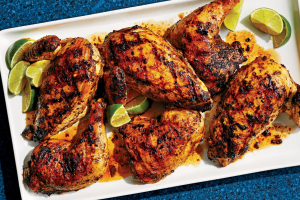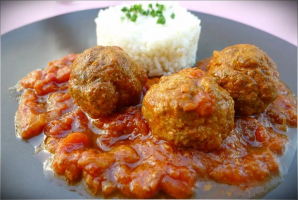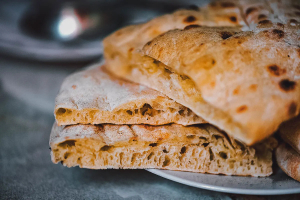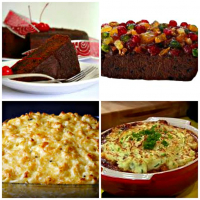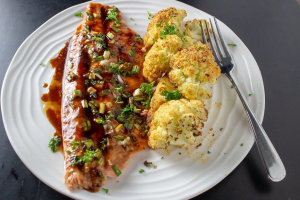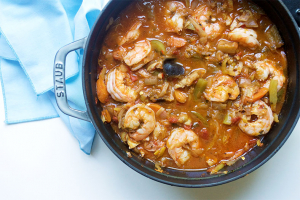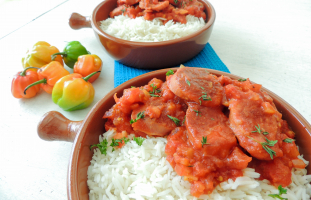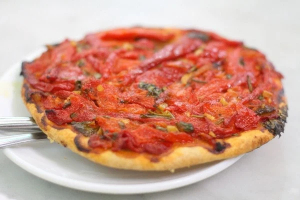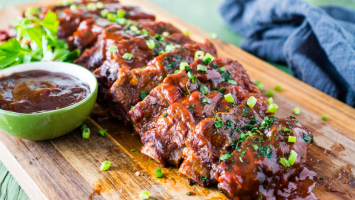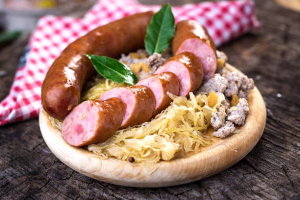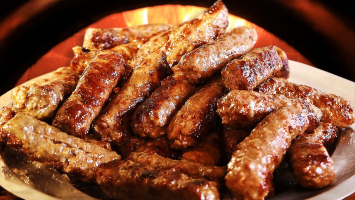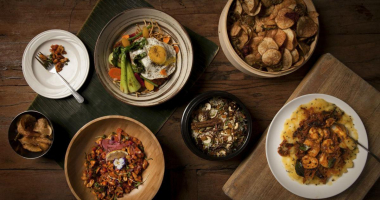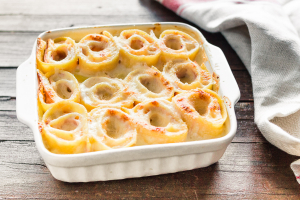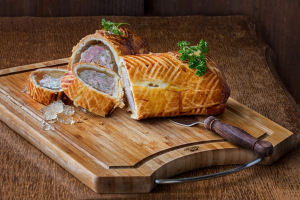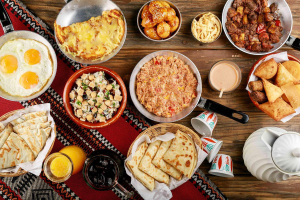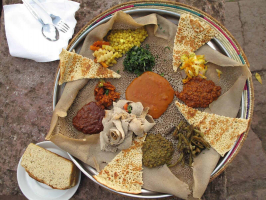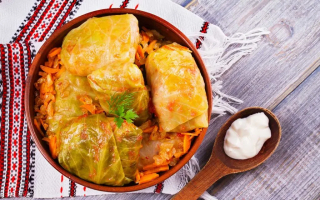Top 10 Best Foods In State Of Palestine With Recipe
To some extent, Palestinian cuisine is similar to that of Jordan, Israel, and other Islamic countries. In Palestine, you may find a variety of Turkish meals. ... read more...Popular Palestinian foods include falafel, sfiha, tabouli, hummus, maqluba, and others. Garlic, onion, coriander, mint, black pepper, and other ingredients are common in Palestinian cuisine. The Palestinian people are primarily reliant on meat and lamb. Let's take a look at some of Palestine's delicacies.
-
Despite the fact that these protein-rich chickpea fritters are recognized as one of Israel's national meals, falafel is sometimes thought to have originated in Egypt, Lebanon, or Palestine. Yemenite immigrants in Israel began preparing falafel on the streets and selling it wrapped in paper in the 1950s to make a living, transforming this historic meal into an early type of Israeli fast food.
Fava beans can be substituted for chickpeas in the Israeli version, and the mixture is often seasoned with parsley, coriander, cumin, and onions. Falafel fritters are most typically served in pita or lafa flatbread sandwiches in Israel and other Middle Eastern nations, topped with fresh or pickled veggies and dipped in hummus paste, tahini dip, or a spicy, garlic-flavored yogurt sauce.
Ingredients
- 2 cups dried chickpeas (Do NOT use canned or cooked chickpeas), ½ tsp baking soda, 1 cup fresh parsley leaves, stems removed, ¾ cup fresh cilantro leaves, stems removed, ½ cup fresh dill, stems removed, 1 small onion, quartered, 7-8 garlic, cloves, peeled, Salt to taste, 1 tbsp ground black pepper, 1 tbsp ground cumin, 1 tbsp ground coriander, 1 tsp cayenne pepper, optional, 1 tsp baking powder
Instructions
- (One day in advance) Place the dried chickpeas and baking soda in a large bowl filled with water to cover the chickpeas by at least 2 inches. Soak overnight for 18 hours (longer if the chickpeas are still too hard). When ready, drain the chickpeas completely and pat them dry.
- Add the chickpeas, herbs, onions, garlic and spices to the large bowl of a food processor fitted with a blade. Run the food processor 40 seconds at a time until all is well combined forming a the falafel mixture.
- Transfer the falafel mixture to a container and cover tightly. Refrigerate for at least 1 hour or (up to one whole night) until ready to cook.
- Just before frying, add the baking powder and sesame seeds to the falafel mixture and stir with a spoon.
- Scoop tablespoonfuls of the falafel mixture and form into patties (½ inch in thickness each). It helps to have wet hands as you form the patties.
- Fill a medium saucepan 3 inches up with oil. Heat the oil on medium-high until it bubbles softly. Carefully drop the falafel patties in the oil, let them fry for about 3 to 5 minutes or so until crispy and medium brown on the outside. Avoid crowding the falafel in the saucepan, fry them in batches if necessary.
- Place the fried falafel patties in a colander or plate lined with paper towels to drain.
- Serve falafel hot next to other small plates; or assemble the falafel patties in pita bread with tahini or hummus, arugula, tomato and cucumbers. Enjoy!
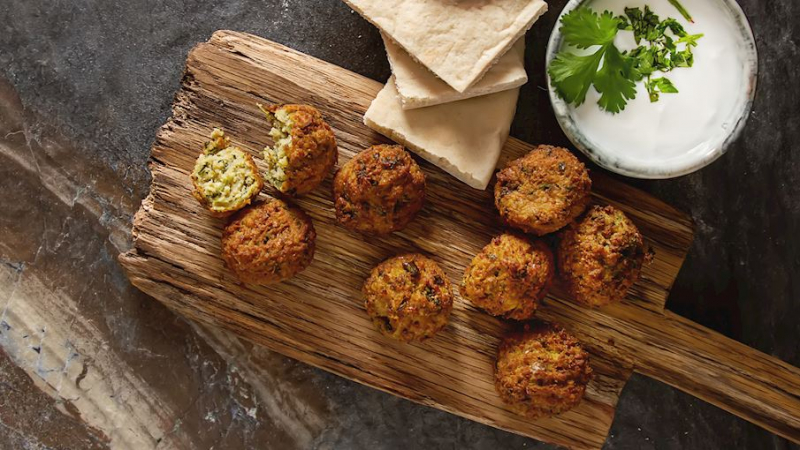
tasteatlas.com 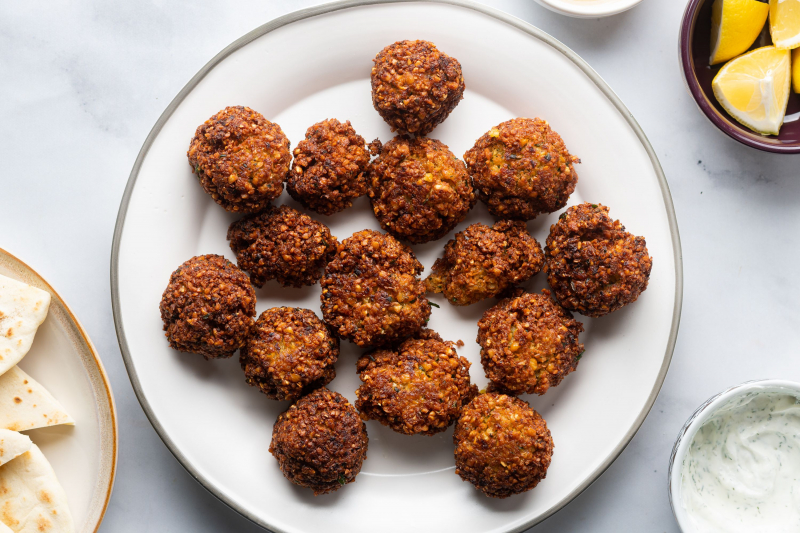
thespruceeats.com -
Lentils and rice are a classic Levantine vegetarian combination that goes well with fresh greens. The meal is made up of cooked rice and lentils that have been enhanced with onions sautéed in olive oil. When prepared, the mixture is frequently topped with fried onions and served with plain or garlic-flavored yogurt (the dish is no longer vegan) and flatbread, which should be used instead of cutlery. Aside from the original form, other variations use bulgur instead of rice, and the dish can be easily customized with different spices and fresh herbs.
Ingredients
- 4 medium cloves garlic, smashed and peeled, 2 bay leaves, 1 tablespoon ground cumin, 1 ¾ teaspoons fine sea salt, divided, Freshly ground black pepper, 5 cups water, 1 cup brown* basmati rice (regular, not quick-cooking), rinsed and drained, 1 cup regular brown or green lentils**, picked over for debris, rinsed and drained, ⅓ cup extra-virgin olive oil, 2 medium-to-large yellow onions, halved and thinly sliced, ½ cup thinly sliced green onions (from 1 bunch), divided, ½ cup chopped fresh cilantro or flat-leaf parsley, divided, Plain whole-milk or Greek yogurt, for serving, Spicy sauce, for serving (optional): shatta or zhoug or store-bought chili-garlic sauce or even sriracha
Instructions
- In a large Dutch oven or soup pot, combine the garlic, bay leaves, cumin, 1 ½ teaspoons of the salt and about 20 twists of freshly ground black pepper. Add the water and bring the mixture to a boil over medium-high heat.
- Once boiling, stir in the rice and reduce the heat to medium. Cover and cook, stirring occasionally and adjusting the heat as necessary to maintain a controlled simmer, for 10 minutes.
- Stir in the lentils and let the mixture return to a simmer. Cover again, reduce the heat to medium-low, and cook until the liquid is absorbed and the rice and lentils are tender, about 20 to 23 minutes.
- Meanwhile, warm the olive oil in a large (12-inch) skillet over medium-high heat. When it’s warm enough that a slice of onion sizzles on contact, add the remaining onions. Stir to combine.
- Stir only every 3 minutes or so at first, then more often once the onions at the edges of the pan start browning. If the onions are browning before they have softened, dial down the heat to give them more time. Cook until the onions are deeply caramelized and starting to crisp at the edges, about 20 to 30 minutes. In the meantime, line a large plate or cutting board with a couple paper towels.
- Using a slotted spoon or fish spatula, transfer the onions to the lined plate and spread them evenly across. Sprinkle the remaining ¼ teaspoon salt over the onions. They’ll crisp up as they cool.
- When the lentils and rice are done cooking, drain off any excess water (if there is any) and return the mixture to the pot, off the heat. Lay a kitchen towel across the top of the pot to absorb steam, then cover the pot and let it rest for 10 minutes.
- Remove the lid, discard the bay leaves, and smash the garlic cloves against the side of the pan with a fork. Add about ¾ths of the green onions and cilantro, reserving the rest for garnish. Gently stir and fluff the rice with a fork. Season to taste with additional salt and pepper, if necessary.
- Transfer the rice and lentil mixture to a large serving platter or bowl. Top with the caramelized onions and the remaining green onions and cilantro. Serve hot, warm or at room temperature, with yogurt and spicy sauce (optional) on the side.
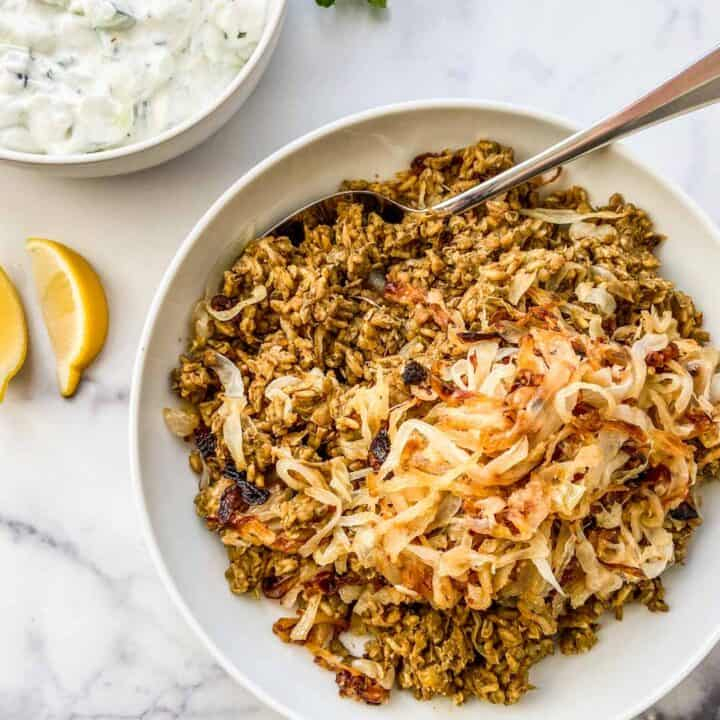
thishealthytable.com 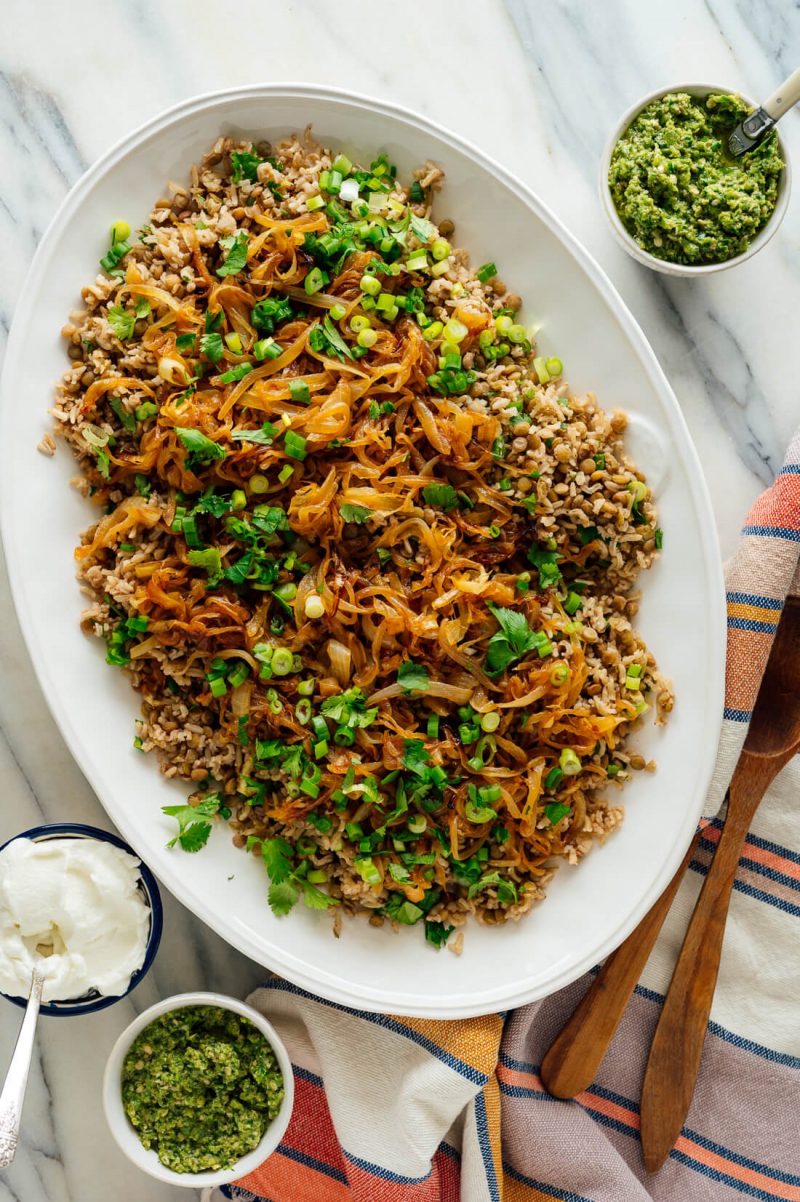
cookieandkate.com -
Traditional ingredients for this beige-colored spread include mashed chickpeas, tahini sesame paste, lemon juice, and garlic. Hummus is loved by people all over the world for its sour flavor and nutritional value. It's usually served with a sprinkle of olive oil and used as a vegetable dip or a delicious stuffing for flatbreads like pita. Even now, little is known about its origins, despite the fact that hummus was first mentioned in Egypt in the 13th century.
Ingredients
- 1 (15-ounce) can chickpeas or 1 ½ cups (250 grams) cooked chickpeas, 1/4 cup (60 ml) fresh lemon juice, 1 large lemon, 1/4 cup (60 ml) well-stirred tahini, see our homemade tahini recipe, 1 small garlic clove, minced, 2 tablespoons (30 ml) extra-virgin olive oil, plus more for serving, 1/2 teaspoon ground cumin, Salt to taste, 2 to 3 tablespoons (30 to 45 ml) water or aquafaba, see notes, Dash ground paprika or sumac, for serving
Instructions
- In the bowl of a food processor, combine the tahini and lemon juice and process for 1 minute, scrape the sides and bottom of the bowl then process for 30 seconds more. This extra time helps “whip” or “cream” the tahini, making the hummus smooth and creamy.
- Add the olive oil, minced garlic, cumin, and a 1/2 teaspoon of salt to the whipped tahini and lemon juice. Process for 30 seconds, scrape the sides and bottom of the bowl then process another 30 seconds or until well blended. Open, drain, and rinse the chickpeas. Add half of the chickpeas to the food processor and process for 1 minute. Scrape sides and bottom of the bowl, then add remaining chickpeas and process until thick and quite smooth; 1 to 2 minutes.
- Most likely the hummus will be too thick or still have tiny bits of chickpea. To fix this, with the food processor turned on, slowly add 2 to 3 tablespoons of water until you reach the perfect consistency.
- Taste for salt and adjust as needed. Serve hummus with a drizzle of olive oil and dash of paprika. Store homemade hummus in an airtight container and refrigerate up to one week.
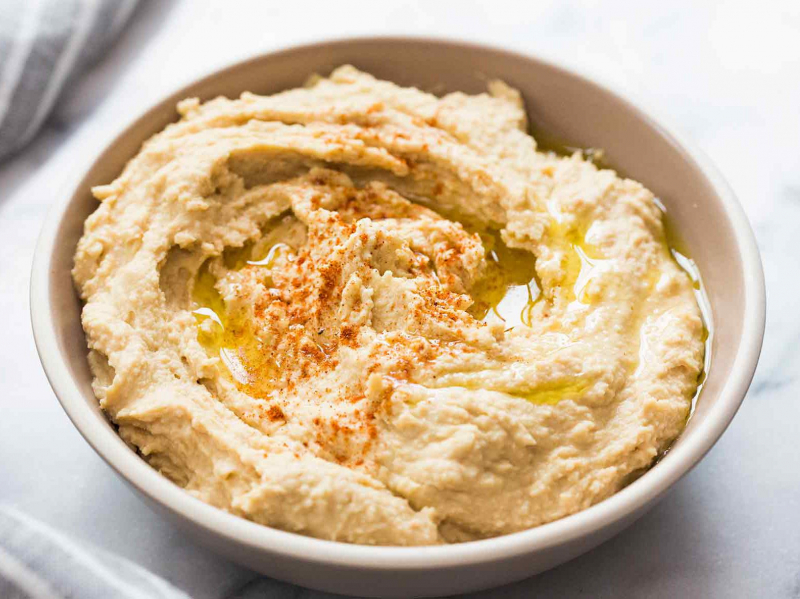
simplyrecipes.com 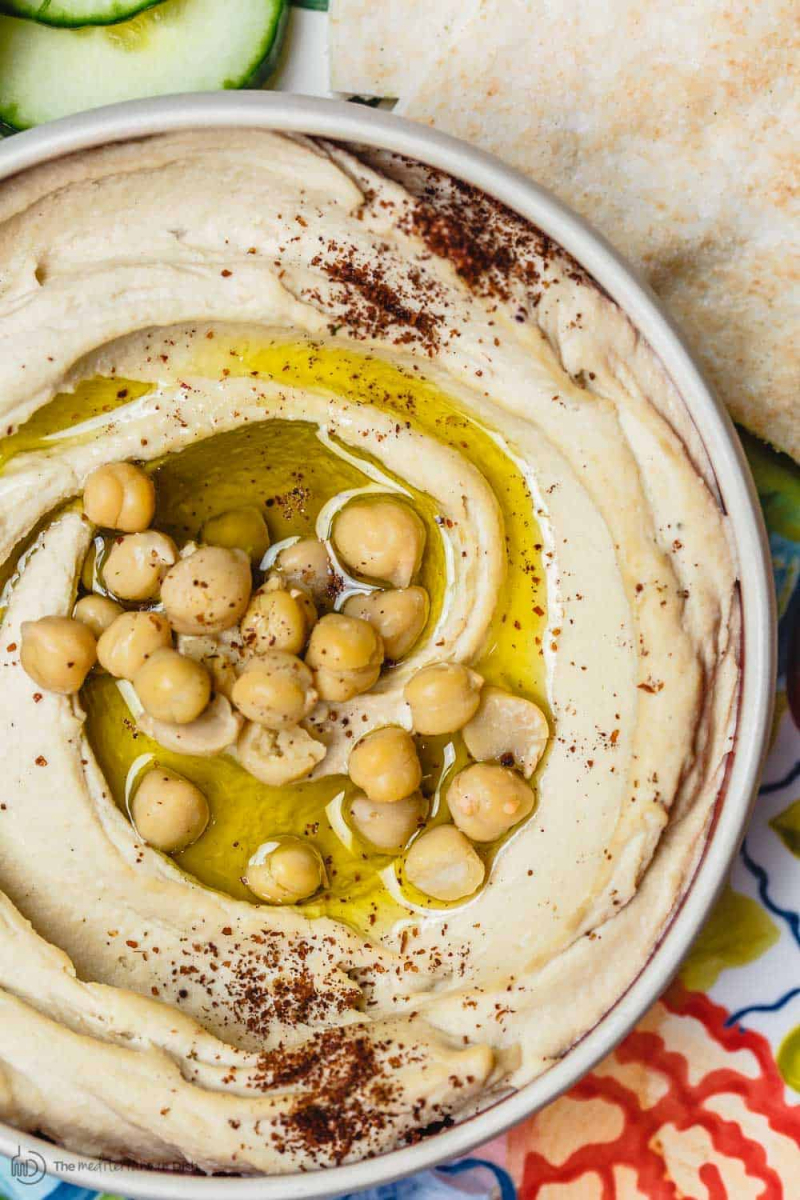
themediterraneandish.com -
Maqluba is Palestine's national dish, although it's also popular in Iraq, Syria, and Jordan. The main premise of this multilayer one-pot dish is to turn it upside down before serving, which is what the word maqluba signifies. Rice, vegetables (carrots, potatoes, tomatoes, cauliflower, onions), herbs and spices (turmeric and sumac), and meat (chicken or lamb) are among the ingredients, though the dish can also be cooked without meat. The ingredients are prepared and stacked before being boiled until no liquid remains. Maqluba is flipped upside down before serving, and pine nuts or minced parsley are often sprinkled on top. A cucumber and tomato salad, olives, and yogurt on the side are recommended accompaniments.
Ingredients
- 1 medium eggplant (1 pound), Salt, 3 ½ pounds bone-in chicken pieces, 1 ½ teaspoons ground black pepper, 1 teaspoon ground cumin, 6 cloves, 6 green cardamom pods, 3 bay leaves, 2 ½ cups long-grain rice, rinsed well and drained, 1 small onion, cut into large wedges, Vegetable or olive oil, as needed, 3 to 5 medium carrots, 2-or-3-inch pieces, 1 medium potato, 1/2-inch slices, ½ medium-head cauliflower, in florets, ¾ cup broken vermicelli noodles (see note), 1 teaspoon ground turmeric, ¾ teaspoon ground cinnamon, ½ teaspoon ground allspice, ¼ teaspoon ground cloves, ½ teaspoon Goya Sazón seasoning (optional), 3 garlic cloves, grated, ⅓ cup pine nuts, Plain yogurt, for serving (optional) Chopped tomatoes, cucumbers, parsley, lemon juice and olive oil, for serving (optional)
Instructions
- Cut the eggplant into 1/2-inch-thick half-moons. Season well with salt, and let sit 30 minutes. Place the chicken in a large pot (a 10-inch, 5-quart size is ideal), and season well with salt and 1 teaspoon black pepper, ground cumin, cloves, cardamom pods and bay leaves (ideally, do this the day before). Pour 3 cups of boiling water over the rice.
- Soak for 10 minutes, then drain well.
- To the chicken, add the onion wedges, 1 tablespoon salt and 4 1/2 cups of water. Bring to a boil, covered, over high heat, then turn down to a simmer, and cook for 20 minutes. Drain the chicken, keeping the broth and discarding the onion and spices.
- Heat 1/2 inch of oil in a large skillet over medium-high heat until shimmering hot, then fry the carrots, in batches if necessary, turning occasionally until browned, about 4 minutes. Drain on paper towels, then season lightly with salt.
- Repeat with the potato, about 3 minutes per side. Repeat with the cauliflower, about 7 minutes per batch. Finally, press the eggplant with paper towel until dry, then fry the eggplant in one layer until browned, about 4 minutes per batch. Drain on paper towels, but don’t season. (If the eggplant is too oily, press on it with paper towels.)
- Pour out the oil, keeping 2 1/2 tablespoons in the pan. Heat it over medium-high heat and add the vermicelli, stirring until browned, about 2 minutes. Add the drained rice and cook, stirring, to dry it out, about 4 minutes. Add 1 tablespoon salt, 1/2 teaspoon black pepper, the turmeric, cinnamon, allspice, ground cloves, Sazón and garlic, and cook, stirring, until very fragrant.
- Place the chicken back in the pot, skin side down. Place the vegetables on top, then rice. Pour in 4 cups of the chicken broth. Press down on the rice; add more broth or water if needed to bring the liquid barely to the level of the rice. Cover the pot and bring to a boil over high heat, then turn it down to medium low. After 10 minutes, carefully stir just the rice to evenly combine the harder rice on top. Repeat after another 10 minutes. After a total of 30 minutes, the rice should be cooked, but not soft, and the liquid should be absorbed.
- Place a very large serving dish on top of the pot, then, protecting your hands (and maybe with a partner), invert the pot onto the dish in one smooth motion. If there is liquid seeping out, spoon it out or soak it up with paper towels. Let the pot rest at least 5 minutes.
- Meanwhile, heat 2 tablespoons of oil in a small pan over medium-high heat until shimmering. Fry the pine nuts, stirring constantly, until browned, about 1 minute. Drain on paper towels.
- Lift off the pot to reveal the maqluba, and scatter the pine nuts all over. Serve with yogurt and chopped tomatoes, cucumbers and parsley on the side, seasoned with lemon, salt and olive oil.
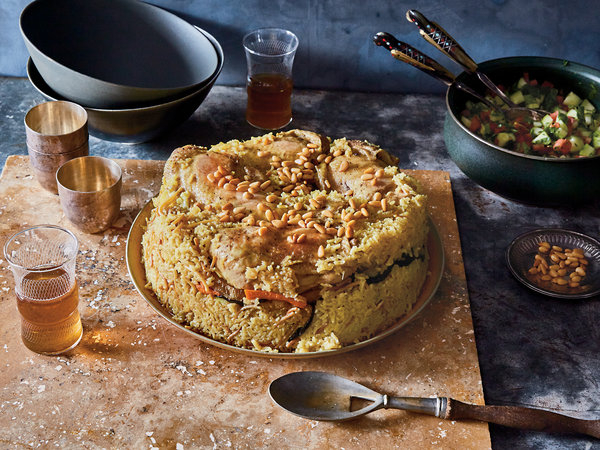
cooking.nytimes.com 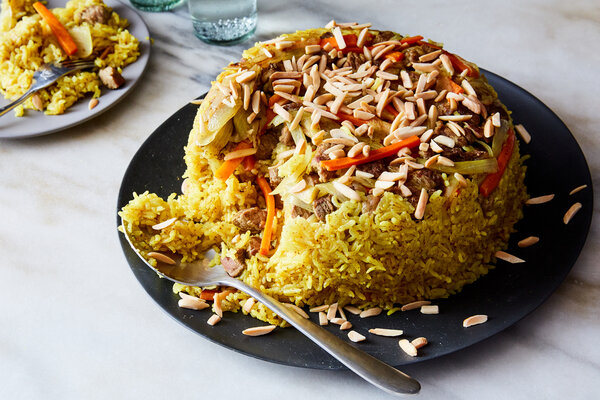
cooking.nytimes.com - 1 medium eggplant (1 pound), Salt, 3 ½ pounds bone-in chicken pieces, 1 ½ teaspoons ground black pepper, 1 teaspoon ground cumin, 6 cloves, 6 green cardamom pods, 3 bay leaves, 2 ½ cups long-grain rice, rinsed well and drained, 1 small onion, cut into large wedges, Vegetable or olive oil, as needed, 3 to 5 medium carrots, 2-or-3-inch pieces, 1 medium potato, 1/2-inch slices, ½ medium-head cauliflower, in florets, ¾ cup broken vermicelli noodles (see note), 1 teaspoon ground turmeric, ¾ teaspoon ground cinnamon, ½ teaspoon ground allspice, ¼ teaspoon ground cloves, ½ teaspoon Goya Sazón seasoning (optional), 3 garlic cloves, grated, ⅓ cup pine nuts, Plain yogurt, for serving (optional) Chopped tomatoes, cucumbers, parsley, lemon juice and olive oil, for serving (optional)
-
Ingredients
- Lamb Preperation: 12 Cuts of medium-sized lamb (preferably lamb shoulder), 2 tbsp Filppo Berio California Extra Virgin Olive oil, 1 tbsp Salt, 1/2 tsp Black Pepper, 1 tbsp Ground Allspice, Boiling Water, 1/2 tsp Turmeric, 1/2 tsp Garlic Powder, 1 Onion, quartered, 4 Bay Leaves, 4 Cardamom Pods, 2 Garlic cloves, 1 Cinnamon stick
- Rice Preparation: 1 tbsp Filippo Berio California Extra Virgin Olive oil, 1 Yellow Onion, chopped, 20 Garlic cloves, halved, 1/2 tsp Ground Cumin, 1/4 tsp Turmeric powder, 1 tbsp Seven Spice, 1 tsp Salt, 2 cups Basmati rice, rinsed in water and drained, 15 oz. Chickpea can, drained
- Garnish: 1/3 cup Toasted Slivered almonds or pine nuts, 1 tbsp Ghee
Instructions
- First, rinse the lamb pieces thoroughly under cold water and trim excess fat if necessary. Pat the lamb dry.
- In a large pot, add the olive oil on medium heat allowing for it to warm up. Once oil is hot, add the lamb pieces and sear for 4 minutes each side to achieve a light browning.
- Season with half of the salt, pepper, and allspice from the ingredient list.
- Then, add enough boiling water to cover 2 inches over the lamb. Let this simmer covered for about 30 minutes. If residue rises to the top, spoon it off.
- At this point, add the rest of the seasonings and components on the ingredient list. Allow to simmer for another 1.5 hours on low to medium heat.
- Once the time has passed, check on the tenderness of the meat, Depending on cut and size, it may need more time but should be ready.
- Take out the lamb pieces and through a strainer on top of a bowl; pour the lamb's broth,
- You will use that same broth to cook the rice in for amazing flavor.
- Wipe the same pot used to cook the lamb and add the olive oil along with the onions. Saute until fragrant which is about 5-8 minutes then add the garlic and sautee for another 5 minutes.
- Season with the spices above and add the rice and chickpeas to this as well. Give it a nice stir so everything is evenly coated.
- Take out a majority of the rice and put on a plate to the side. Leave a layer of rice in the pot and top it with half the lamb pieces then add the remaining rice and top with the remaining lamb.
- Add enough broth on top of this to cover the rice 1 inch over. Put a heat proof plate that fits the pot on top of the rice to keep things in place while cooking. Store extra broth in a container in the fridge to use for future purposes.
- Cook the rice covered with a lid for about 20-25 minutes on low to medium heat making sure not to scorch the bottom of the pot. Once the liquid is evaporated and the rice is cooked through turn off the heat. Allow for the rice to stay in the steam for another 5-10 minutes before serving onto a platter of your choice.
- Top with toasted slivered almonds and/or pine nuts in ghee. Enjoy with a refreshing Arabic salad and plain yogurt.
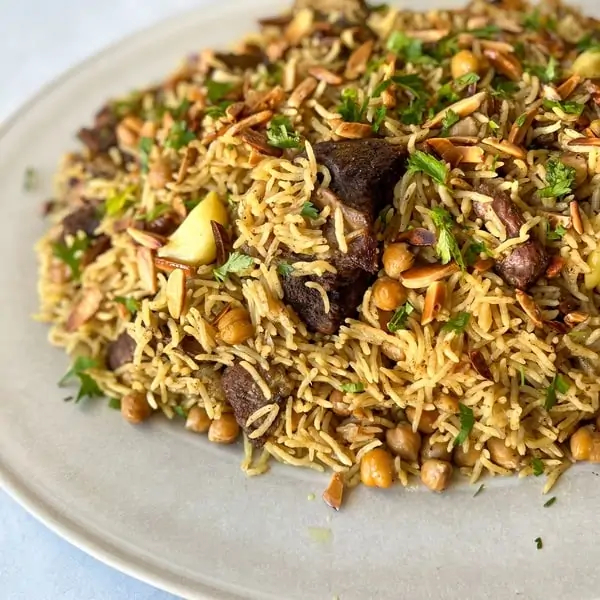
fufuskitchen.com 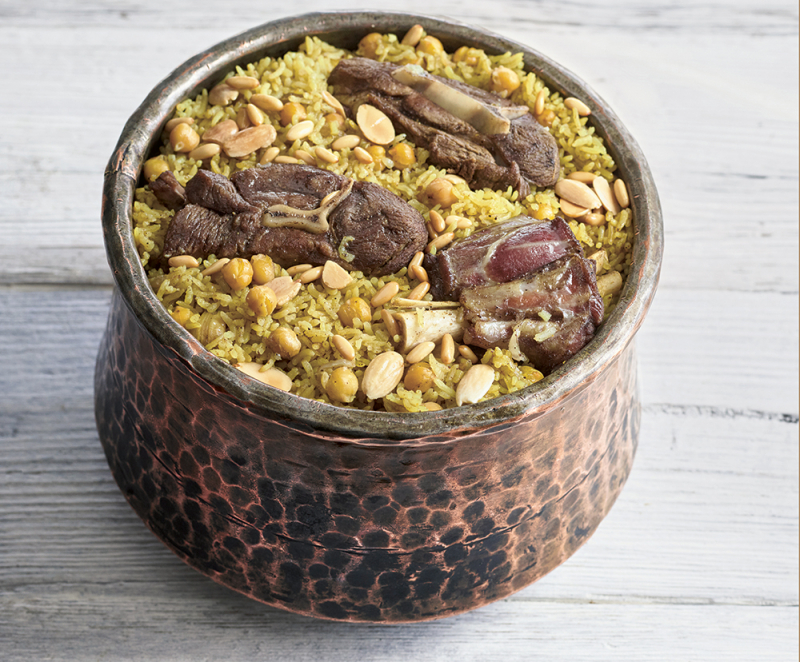
qualityfoodanddrink.com -
Musakhan is a Palestinian meal made with roasted chicken and caramelized onions, topped with pine nuts and served on top of taboon bread that has been soaked in olive oil. The dish's name is derived from the Arabic word sakhan, which, when translated, denotes a hot manner of preparation. Sumac, a spice that is added to onions and gives the meal a tangy, lemony flavor, is a significant ingredient in musakhan. Nowadays, this dish is frequently served as a wrap, pizza, or lasagna, with the bread and onion combination alternated with chicken on top.
Ingredients
- 1 tsp. ground allspice, ½ tsp. ground cardamom, ½ tsp. ground cumin, 2 Tbsp. sumac, plus more for sprinkling, 4 whole chicken legs (thigh and drumstick; about 2½ lb. total), Kosher salt, ¼ cup plus 1 Tbsp. extra-virgin olive oil, 3 medium white onions, coarsely chopped, ¼ cup pine nuts or slivered almonds, Taboon bread or Turkish or Indian flatbreads, warmed (for serving), 1 lemon, halved
Instructions
- Preheat oven to 350°. Mix allspice, cardamom, cumin, and 2 Tbsp. sumac in a small bowl to combine.
- Season chicken all over with salt in a large bowl. Rub with half of spice mix, pressing and working it into the meat.
- Heat ¼ cup oil in a large ovenproof skillet over medium-high. Cook chicken, turning occasionally, until golden brown on both sides and some fat is released, 3–5 minutes per side. Transfer chicken to a large plate, leaving fat in skillet.
- Return skillet to medium-high heat. Cook onions, scraping any browned bits on bottom of skillet and adding a splash of water if pan gets dry, until softened and golden brown, 18–25 minutes. Sprinkle with remaining spice mix and continue to cook, stirring frequently, until fragrant, about 30 seconds. Add ¼ cup water, season with salt, and bring to a simmer. Nestle chicken back into skillet, skin side up, and transfer to oven. Bake, uncovered, until liquid is mostly evaporated and chicken is cooked through, 30–35 minutes. Let cool 10 minutes in skillet.
- While chicken is cooking, toast pine nuts in remaining 1 Tbsp. oil in a small skillet over medium heat, stirring frequently, until golden brown and fragrant, about 3 minutes. Remove from heat and season with salt.
- Arrange warmed bread on a platter and top with chicken and onions. Scatter pine nuts over and sprinkle with more sumac. Squeeze juice from one lemon half over chicken. Cut remaining lemon half into wedges to serve alongside.
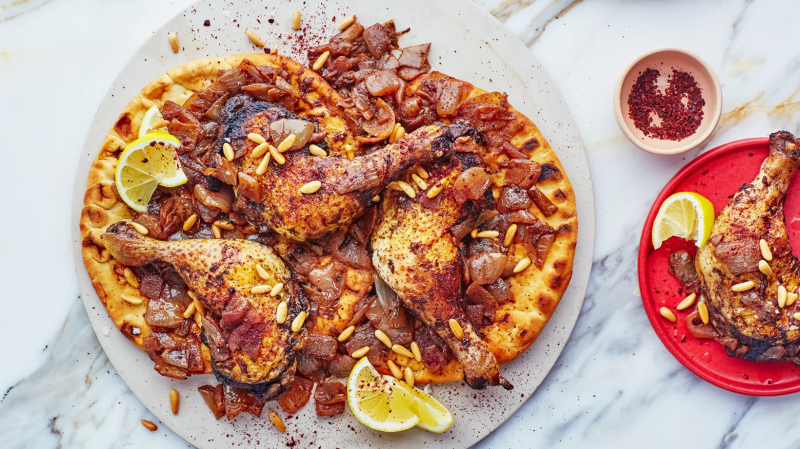
thehappyfoodie.co.uk 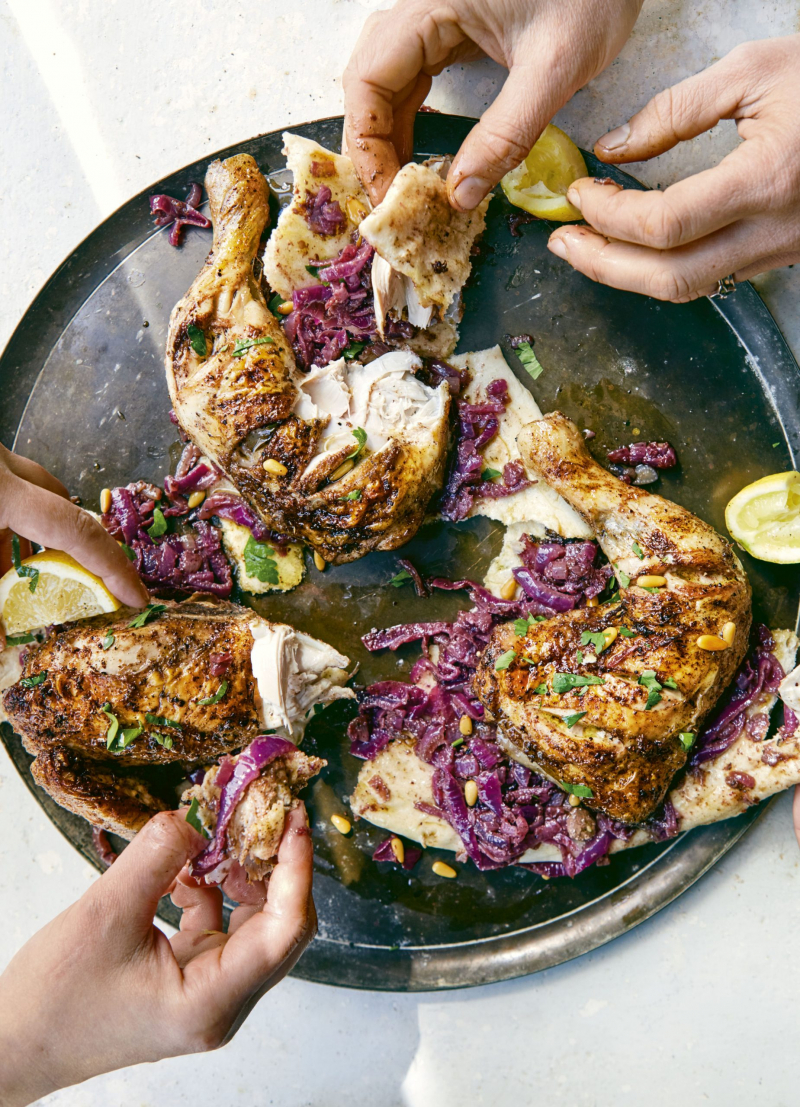
thehappyfoodie.co.uk -
Kunfah is made with two crunchy layers of shredded and buttered kataifi or knefe dough, a delectable cheese cream scented with orange zest and cardamom, and a sugar syrup infused with lemon juice and orange blossom water. Hatay, Urfa, and Antep cheeses are used to make Turkish künefe. Pistachios are generally sprinkled over top, and it's best served warm. Elegant and incredibly simple to make
Ingredients:
- FOR THE SYRUP: 2 ¼ cups sugar1 ¼ cups water, 2 tbsp orange-blossom water
- FOR THE CREAM FILLING: 2/3 cup rice flour, 5 cups milk, 4 tbsp sugar, 2/3 cup heavy cream
- FOR THE PASTRY: 1 lb kunāfah pastry, 1 cup butter, melted
- FOR GARNISHING: 2/3 cup pistachios, coarsely chopped
Instructions:
- Prepare the syrup first by boiling the sugar, water and lemon juice for 8-10 minutes. Add orange-blossom water, cool to room temperature and place in the refrigerator.
- Now, prepare the filling. Make a smooth paste from rice flour and some milk, and boil the rest of the milk. Slowly add the rice flour paste, mixing constantly, so no lumps are formed. Put the heat to lowest setting and cook for 15-20 minutes until it becomes thick. Add the sugar and stir again. Allow to cool and then add heavy cream.
- Drizzle the kunāfah pastry with melted butter and gently separate the strands to coat evenly.
- Take a 12-inch round pie pan and spread half of the pastry on the bottom and sides. Pour the cream filling and cover with the other half of the pastry.
- Bake for 45 minutes on 350˚F, and then for another 15 minutes on 425 ˚F.
- Loosen the sides with a sharp knife, cover the kunāfah with a large plate, and turn out. Drizzle with cold sugar syrup and sprinkle with pistachios.
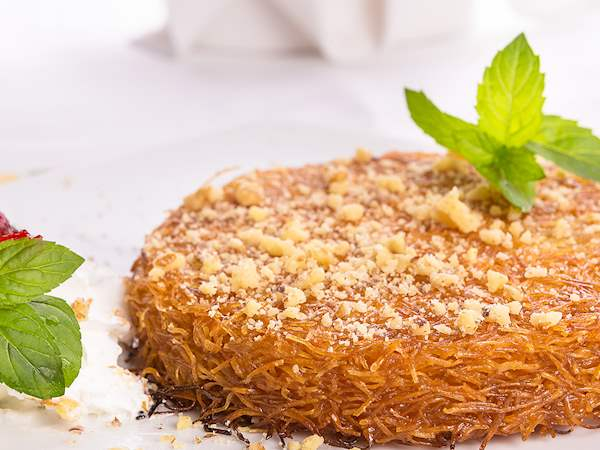
tasteatlas.com 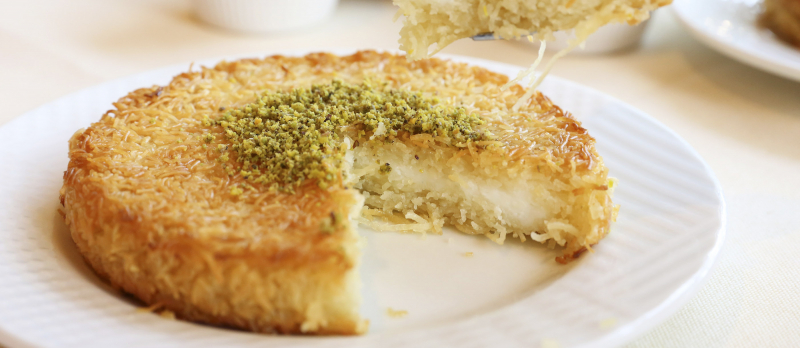
tasteatlas.com - FOR THE SYRUP: 2 ¼ cups sugar1 ¼ cups water, 2 tbsp orange-blossom water
-
The fundamental characteristics of labneh, a typical Middle Eastern strained yogurt made with yogurt and salt, are its creamy texture and mild flavor. It is made without any particular standards; plain full-fat yogurt is blended with salt and left to filter for 12 to 24 hours. The yogurt whey separates during the straining process, leaving a thick and solid cheese-like result. It comes in a variety of textures, from creamy to dense, but it always has a mild, somewhat salty flavor. Although labneh is a Middle Eastern word, strained yogurt variations can be found in a variety of nations and locations, including Greece, Turkey, Cyprus, Central Asia, the United States, Mexico, and the United Kingdom.
Ingredients:
- 32 oz whole milk yogurt, ¾ tsp salt, Early Harvest Extra Virgin Olive Oil, Za'atar spice or chopped fresh herbs, Warm pita bread, Sliced vegetables of choice
Instructions:
- Pour the yogurt into a large bowl. Stir in salt.
- Line another large bowl with a linen or muslin towel (or several layers of cheesecloth.) Pour the yogurt mixture into the towel. Pick up the edges of the towel and tie at the top. Hang from a kitchen sink faucet to drain for 24 to 48 hours. (Alternatively, set a large sieve, lined with linen towel over a deep bowl. Add the yogurt mixture. Cover gently with the overhang of the linen towel, or another linen towel. Set aside on the counter, or in the fridge, to drain for 24-48 hours)
- To serve, spread labneh in a bowl and top with extra virgin olive oil, za'atar spice (or chopped fresh herbs like mint or parsley). Add warm pita and fresh veggies for dipping. Enjoy!
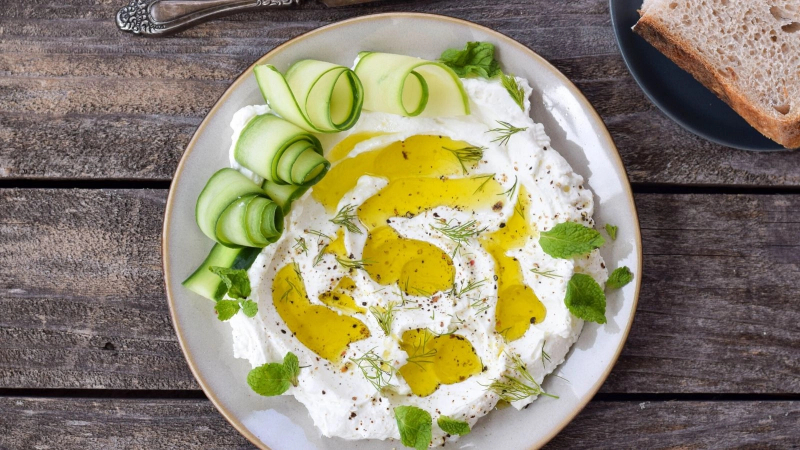
myjewishlearning.com 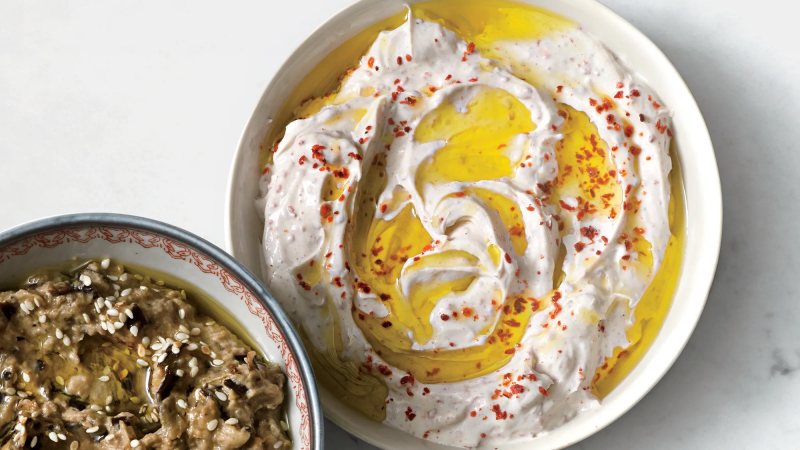
myjewishlearning.com -
In Levantine and Middle Eastern cuisine, oil-cured eggplants are a mainstay. Small baby eggplants are boiled briefly and stuffed with a tasty mixture of roasted red peppers, walnuts, garlic, and salt in a traditional preparation. The eggplants are then cured in olive oil and served as a breakfast dish with labneh, veggies, and flatbread, but they can also be served as a typical meze dish or snack. Preserved eggplants are strongly linked with Syria, despite their ambiguous origins.
Ingredients
- 18 baby eggplants, 2 red peppers, 3 chill peppers small ones, 1 cup walnuts, 3 garlic cloves
Instructions
- Boil enough water in a large saucepan and then add the eggplants. Boil for 5-10 minutes until the eggplants are softened
- Once they have softened, turn off the heat and let them rest in the water for 10-15 minutes. Then drain them.
- Cut the tops of the eggplants. Then carefully slice half-way through, lengthwise - like a book.
- Rub some salt on the inside of each eggplant then arrange them on a flat surface, not touching each other and press them with a heavy object. You could use a big pan lid or the bottom of a flat dish to place on top of them, then add another heavy object on top. Alternatively, you could arrange them within a colander and press with a heavy object.
- With the combination of pressing and salt, this should help remove all the excess water from the eggplant. Keep them pressed for a few hours or even overnight to get as much of the water out as possible. The key is to keep them in a cool area, and this process can take up to 24 hours, do be patient and check them after every 5-6 hours. See video.
- When you are ready to proceed, first make the stuffing. Slice the peppers and remove all seeds. Then either finely chop them or blitz them in a food processor/blender for a bit.
- Next, strain the liquid from the crushed peppers. You can put them in a sieve and press out all the excess liquid.**
- Mash or grind the garlic cloves and roughly chop the walnuts. If you prefer, you can grind the walnuts into even smaller pieces. Then, mix the peppers, nuts and garlic together.
- Stuff the eggplant shells with about 1 tablespoon of the pepper walnut mixture. Depending on the size of the eggplants, adjust the amount.
- For the next step, use a sterilised clean glass jar. To sterilise the jar, simply wash it with hot water, then put it in the oven (no rubber parts) for 10 minutes at 160ºC. Or after washing, pour boiling hot water over the jar ( just make sure it's heat-safe!
- Arrange the stuffed eggplants in the jar. Stack them carefully so that the stuffing doesn't fall out
- Sprinkle liberally with salt on top then fill the jar with olive oil. Make sure all the eggplants are entirely covered and tightly close the jar.
- Store your jar in a cool, dark place such as a kitchen cupboard. The pickled eggplants - Makdous - will be ready in about 10-14 days ( although some people find they're ready at seven). If at any point you notice that the olive oil isn't entirely covering the eggplants, add more olive oil.
- If you keep them in the oil, completely covered, the Makdous can keep for up to a year. No need to refrigerate, just keep at room temperature in your cupboard as the olive oil acts as a natural preserver.
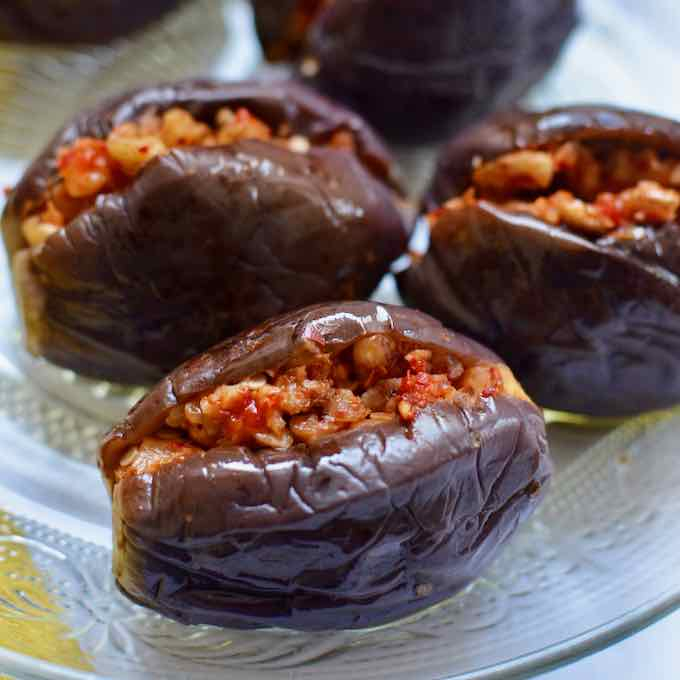
alphafoodie.com 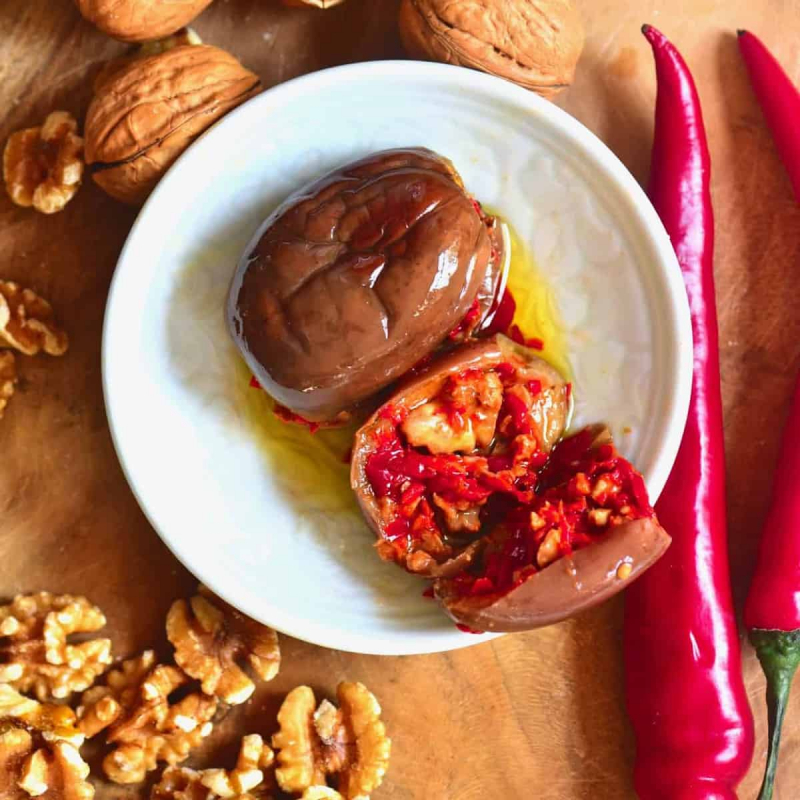
alphafoodie.com -
Shakshouka is a delectable dish of poached eggs in a spicy tomato sauce. Despite its strange name, the dish is simple and straightforward to prepare. It's often made in a skillet with onions, tomatoes, and spices simmered till a lovely tomato sauce forms. The eggs are then poached in the tomato sauce until they are done. The meal can also include Merguez sausage. Although shakshouka is thought to have originated in Tunisia, the dish is now popular throughout North Africa and the Middle East.
Ingredients
- 2 tablespoons olive oil, 1 onion, chopped, 2 anaheim peppers, seeded and chopped, 1 jalapeño or habanero pepper, seeded and finely chopped, 1 (28-ounce) can diced tomatoes, 1/2 cup vegetable broth, 1 teaspoon cumin, 1 teaspoon smoked paprika, 1/2 teaspoon dried oregano, 1/2 teaspoon salt, 1/4 teaspoon freshly ground black pepper, 6 to 8 eggs, 2 tablespoons chopped parsley 1/4 cup crumbled feta cheese
Instructions
- In a large, deep skillet, heat oil over medium-high heat. Add onion and peppers and cook until softened and beginning to brown, about 7 minutes. Add tomatoes, vegetable broth, cumin, paprika, oregano, and salt and pepper; simmer for 20 to 22 minutes or until thickened.
- Crack eggs evenly on top of sauce; cover and cook for 6 to 8 minutes or until whites are set and yolks are thick but runny (if you like firmer yolks, cook for 1 to 2 minutes more). Sprinkle with parsley and feta cheese and serve with warm pita bread.
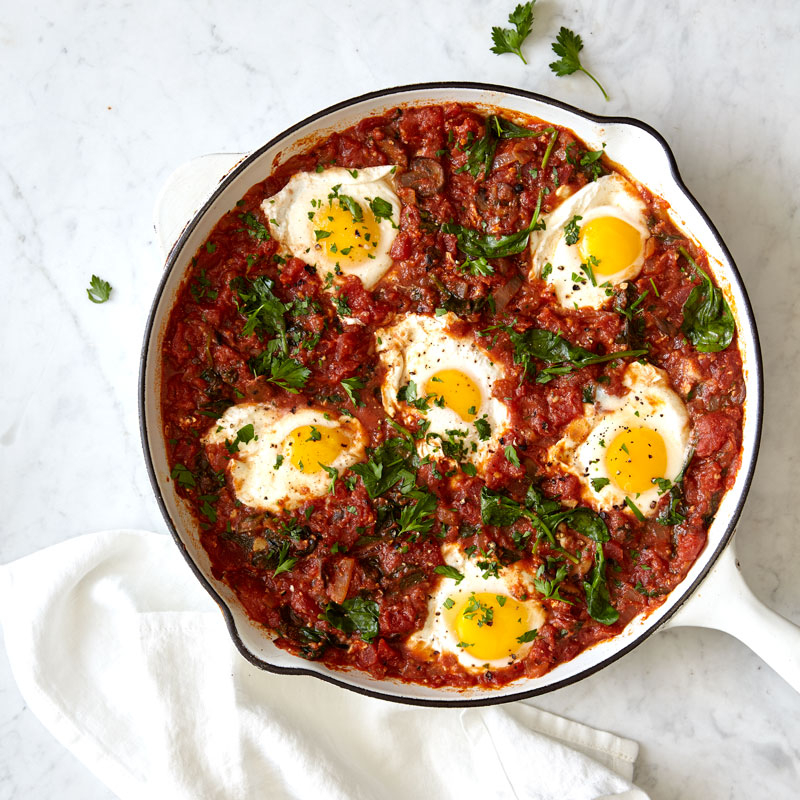
weightwatchers.com 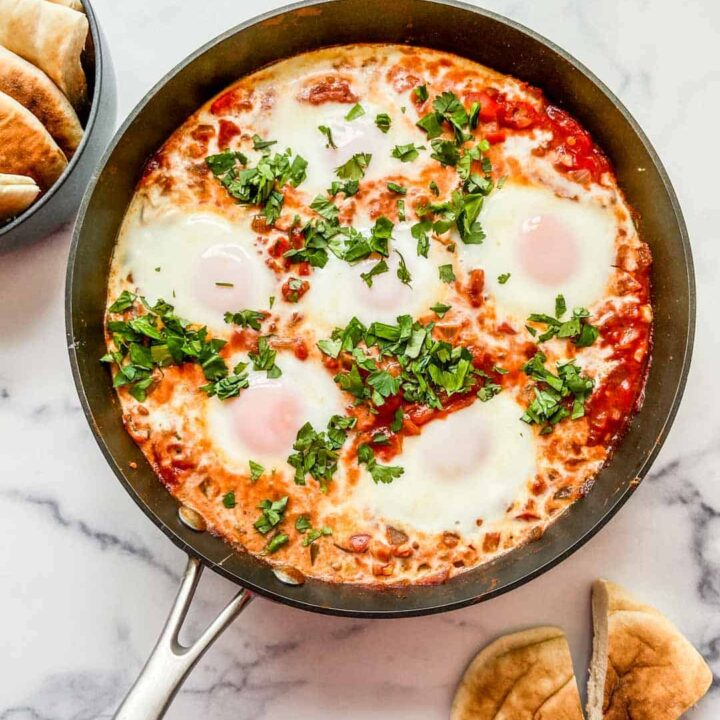
weightwatchers.com












